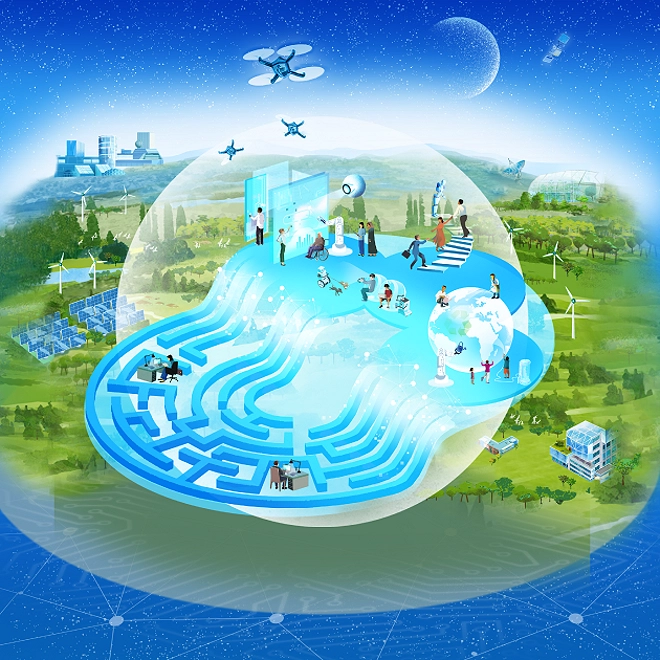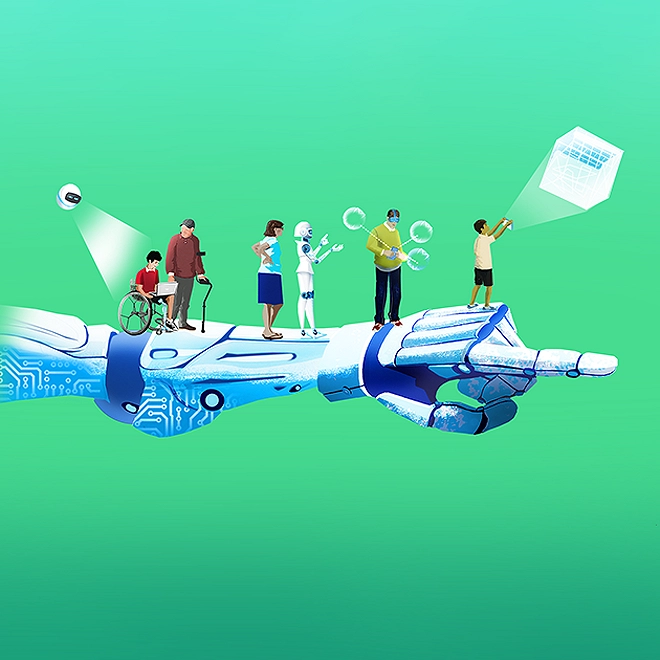Elevating the focus on human risk
Opening the aperture and changing the lens on risks to focus on the human element
Co-authored by John Forsythe.
As C-suites and boards of directors grapple with contingencies for a growing list of disruptive external risks—including environmental, social, technological, political, and economic issues—they should consider expanding their focus beyond the operational and financial effects of those risks, to include the human implications. It is imperative they understand that the impact of these disruptive risks on humans (both inside and adjacent to organizations) is substantial, as is the linkage between the human impact and that of the organization at large. Seeing these disruptive risks through a human lens paves the way for greater resiliency, enables superior business results, and creates a more effective and informed set of solutions for mitigating—and thriving in the face of—these disruptions.
When it comes to human-related risks, organizations and their most senior leaders focus on a narrow set of workforce risks—the potential risks that human workers pose to the business. These risks include operational concerns such as worker turnover, poor efficiency, difficulty acquiring and retaining talent, and compliance with regulations. Typically, their primary focus, if they have a focus at all, has been on the financial and operational impact of these risks. C-suites and boards have only occasionally expanded their focus to include their reputational implications and, more rarely, their human effects.
"Most boards are not handling human risks as a strategic issue." — Mike Fucci, board member at Acadia Healthcare and Flotek Industries; retired Deloitte chairman
Yet all risks have a significant human element. Some have an outsized effect on humans. Others are affected and driven to some degree by humans. As such, we refer to these as human risks because they affect humans’ professional and personal lives in palpable ways, in addition to the impact they have on your organization’s short-term performance, long-term viability, and reputation and brand.
Given the criticality of these human risks, they require the same attention and investments as traditional measures of risks. However, findings from the Deloitte 2023 Global Human Capital Trends survey shows this level of prioritization on human risks is lacking across several dimensions:
- Environmental. Climate change and the availability of natural resources could profoundly alter the availability, location, and conditions of work as well as the workforce. According to the Deloitte 2023 Global Human Capital Trends survey, only 18% of respondents believe climate will be a top risk facing their organization in the next 2–4 years. Yet, there are clear signs this will continue to drive where work gets done, how work gets done, and the local availability of workers.
- Social. Injustice and inequality don’t stop at the workplace door. These social issues can affect how workers feel about work, how they collaborate, and their sense of value and belonging to their organization. According to Deloitte’s Global 2022 Gen Z and Millennial Survey, two in five workers have rejected a job or assignment because it did not align with their values around societal and environmental impact and/or diverse and inclusive cultures. However, only 12% of the Deloitte 2023 Global Human Capital Trends survey respondents believe social and racial injustice will have a substantial impact on the workforce in the next 2–4 years.
- Technological. Data privacy and security, virtual work, and automation are vital to the health of a business, but they also shape the experience of getting work done and the types of work available to humans. Yet only 9% of the Deloitte 2023 Global Human Capital Trends survey respondents noted that their organizations believe technology replacing humans is a top risk facing their workforce today. And just 21% believe cyber risks like data privacy and security will have a significant impact on the workforce.
- Economic. The impact of income disparities—including access to health care, food, and education—affect the abilities and effort that people bring to their work, yet only 30% of respondents acknowledge the workforce impacts of this risk.
- Political. Government regulation and political polarization or conflict profoundly influence the nature of the worker-organization relationship and the relationships workers have with one another, yet only 24% of Deloitte 2023 Global Human Capital Trends survey respondents expect this to have a significant impact on their workforce over the next 2–4 years.
These risks don’t occur in a vacuum: Economic risks often drive social ones, environmental risks place different burdens on technology, and so on. The common thread is that all these risks have a distinct human impact. This impact should be addressed not just at the strategy table, but in the everyday lives of the humans throughout the ecosystem who contribute to your business.
Signals: This trend applies to you if…
- Your organization lacks the data needed to report on a broad set of human risks
- You are struggling to understand what is impairing the organization’s ability to recover from unexpected events or disruptions to their business
- Your board and C-suite expect and need more transparent workforce data to make basic decisions
- Your organization is struggling to demonstrate progress on its DEI commitments
The readiness gap: Is there a lack of understanding?
According to the Deloitte 2023 Global Human Capital Trends survey, 81% of respondents acknowledge the importance of anticipating and considering broader societal and environmental risks like political instability and social injustice when making workforce decisions. Yet less than 19% believe their organizations are very ready to address those risks when making workforce decisions.

The current approach to managing workforce risk is insufficient, with only 44% of executives in Deloitte’s forthcoming Workforce Risk survey believing that the risk-related metrics their organizations capture give an adequate view of current exposure to workforce risk. That figure falls to 34% when executives are asked to evaluate their preparedness over the next three years.
The new fundamentals
Consider a more expansive set of risks and create a framework for monitoring them. Shifting to a focus on human risks requires a more expansive framework that accounts for the complexity and dynamism of today’s world of work. That means moving beyond outdated models that only consider a limited set of internal factors, such as open roles, succession plans, and workforce safety, to account for a broader set of both internal and external human risks. This new framework must look comprehensively at what work is performed, how work is performed, and where work is performed. It must also consider the well-being of the communities in which the organization operates, the well-being of the workforce, and the long-term employability of the workforce—and whether the organization is “future-proofing” workers by helping them acquire transferable skills and capabilities.
Even under today’s narrow lens of workforce risk, few organizations are meeting the mark. According to our forthcoming Workforce Risk survey, only 40% of organizations have a clear definition of workforce risk and less than 10% of executives say they are satisfied with how their organization monitors risk. This is especially concerning given the limited set of risk measures today, with few organizations considering expanded metrics like the impact of inclusion (27%) or environmental, social, and governance (ESG) (16%) on the workforce.
For those who get it right, there’s no question of the benefit to their business. The same survey revealed that organizations that create more structure and discipline around how human risks are managed to achieve enhanced business results. Those organizations are more likely to outperform peers on profitability, operational efficiency, worker satisfaction, and brand recognition.
Create organizational agility through expanded insights. Human risks don’t follow an organization’s planning timeline. Instead, they emerge quickly, often catching organizations off-guard and sending leaders scrambling to respond. Beyond determining consistent definitions and instituting a human risk framework, organizations need to enhance business planning and ongoing risk measures to evaluate progress in a more timely manner. Yet only 40% of the organizations surveyed say they are implementing data and analytics to better sense and prepare for emerging human risks. And, only 43% plan to do so within the next 2–4 years.
The ability to generate those analytics depends on an integrated data infrastructure that can ingest expanded human risk factors and provide consumable insights for organizational response. For instance, consider how an enhanced understanding of human risk, including workforce factors and the broader economic, political, technological, social, and environmental landscape, could influence business decision-making. This might include determining where to open a new manufacturing facility, which workforce skilling and benefits programs to offer, or how an organization plans to support workers, redirect supply chains, or pivot business priorities in the event of a climate or public health emergency.
Even in instances in which the analytics are not predictive, they still increase organizational agility by providing a foundation by which actions can quickly be taken, evaluated, and adjusted in times of disruption. And the insights generated will allow organizations to focus on a broad set of human risk outcomes: financial, operational, regulatory, reputation, and brand.
Instill responsibility at the board-level so it cascades through the organization. The limited emphasis placed on human risk management has traditionally fallen to an organization’s chief human resources officer and on occasion, its chief financial officer. Even simple knowledge or understanding of workforce-related risk appears to be limited outside the human resources department.
"The most ineffective way to approach human risks is to say this is an HR-only issue."
— Mike Fucci, board member at Acadia Healthcare, Flotek Industries; retired Deloitte chairman
According to Deloitte’s Workforce Risk Survey,1 only 40% of board members have expert-level knowledge of workforce-related risks. Today’s global disruptive risks can have a material effect on a company’s long-term viability and need to be fully understood by all executives, but particularly by board members. Boards should embrace responsibility for human risks head-on in service of the investor and stakeholder needs of today and tomorrow, which requires more than just creating or expanding existing subcommittees to take ownership.
Accountability cannot end with the board. Instead, it must cascade through the organization so that monitoring and preparing for human risks becomes a way of operating. And yet, only 39% of our Workforce Risk Survey respondents noted that line managers have expert-level knowledge of workforce-related risks. These line managers are often closest to and most in tune with worker sentiment on the ground. Creating human connection among workers and with the organization can help preempt human risks, just as neighbors feel shared accountability to look out for their street. As discussed elsewhere in this report, continuous dialogue between the organization and its workers is a critical component to engage and activate the workforce when it comes to human risk.
Current experiments: What leading organizations are exploring
- Gard. The Norway-based global insurance provider actively conducts scenario planning around potential risks, including those posed to the workforce. The company identifies a broad list of potential risks related to socioeconomics, environment, geopolitics, and technology, and then asks both the board and managers which they believe are most likely. Gard then conducts scenario planning around these risks with cross-functional working groups to identify potential solutions.2
- MetLife. The global insurance provider places responsibility for ESG risks with the board and they meet with executives regularly to review data to evaluate climate risks. The organization is currently developing the ability to stress test and conduct scenario planning around climate change.3
- US Department of the Treasury. The Bureau of the Fiscal Service has started to take a more expansive view of the risks it evaluates including workforce risks, which are now part of its enterprise risk framework. The agency also plans to advance its data and analytics capabilities to further support evaluation of and decision-making around risks.4
The path forward

Looking ahead
A human-centered, predictive approach to managing risk requires a significant mindset shift for leaders and workers alike—as well as an additional investment. However, the dangers of sticking with the status quo far outweigh the costs of improvement. Executives who do not prioritize a broader, more human-centric approach to risk management could find themselves at odds with board members, and other influential stakeholders, who are increasingly interested in how human risks are managed.
While the board ultimately needs to be accountable, it will take your entire workforce to effectively care for human risks. Many human risks are caused by “wicked problems” in that they are complex, dynamic, and seemingly intractable social challenges.5 The same kind of ecosystem thinking that informs business strategies can be brought to bear on its human risks, pulling on the talents and resources of workers, executives, and the communities in which they operate to co-create solutions.
Leading organizations continue to expand their sensing capabilities and collaborate with workers to predict and plan for all forms of human risk. Those that don’t may soon find themselves outpaced and overwhelmed by emerging challenges and disruptive risks—and unable to react effectively, much less capitalize on new opportunities. Continuing to apply a traditional business-centered perspective to risk management may signal to workers, and even customers, that the organization does not prioritize workers, which can ultimately adversely affect the organization’s financial and operational performance, reputation, and brand.
Deloitte’s 2023 Global Human Capital Trends survey polled 10,000 business and HR leaders across every industry, with 105 countries participating. The survey data is complemented by interviews with executives from some of today’s leading organizations. These insights shaped the trends in this report.
Human Capital
Deloitte’s Human Capital professionals leverage research, analytics, and industry insights to help design and execute the HR, talent, leadership, organization, and change programs that enable business performance through people performance. Visit the Human Capital area of Deloitte.com to learn more.



